Gameism is a modern, practical philosophy derived from a tiny computation.
Computer science is modernizing every facet of society — finance, transport, healthcare. Gameism applies the same first-principles thinking to the world's oldest problem: what is the meaning of life, and how should I live it?
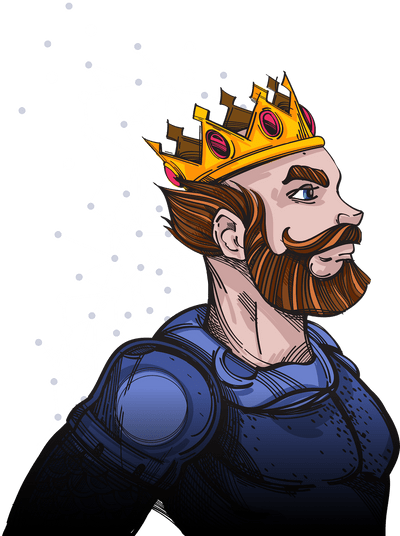
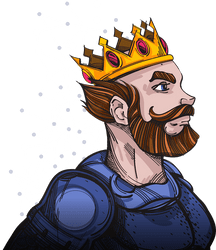

The
Source Code
You are reading these words right now, so you know with 100% certainty that your consciousness exists. Let's call you the observer 👁️.
You can also observe a 3D world outside of yourself. Let's call this 3D world the observed 🏠.
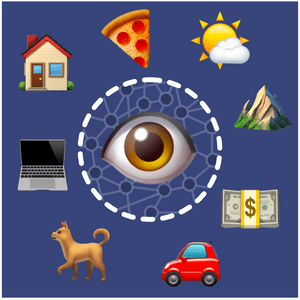
The observed 🏠 is everything outside of the observer 👁️.
I'll now parse this information through three boolean functions. A "boolean function" is a question with two possible outcomes: true or false.
the observer 👁️ and the observed 🏠 the same thing?This is the most fundamental question about the universe, yet scientists never bothered to ask it. Because according to the scientific method, the answer is true by default. Basic logic confirms what mystics have been saying for millennia: the universe is a "non-dual" illusion — like a computer game, or a simulation.
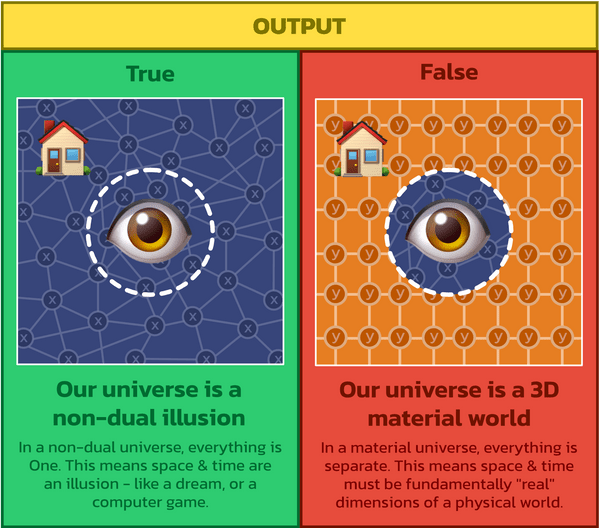
You know with 100% certainty that your consciousness (x) exists. The world outside of you could also be x, or it could be a separate, redundant entity (y) — an entity that you have no evidence for. Hence, if you believe in y, you do it on blind faith. And blind faith is not science — it's religion.
( 2 minute read )
Are the observer 👁️ and the observed 🏠 the same thing?
If the answer is true, then we live in a non-dual universe where everything outside of you is you. This means the dimensions of space and time must be emerging from a lower dimension where everything is One.
The following video is the perfect example of non-dualism. It depicts four AI agents playing hide and seek in a virtual world...
Video by OpenAI
Based on the stream of information being fed into their neural network, these AI agents believe they're pushing around 3D boxes and bumping up against solid walls. But actually, the agents (the observers 👁️) and their "physical" world (the observed 🏠) are the same thing in the lower-dimensional codebase: 1s and 0s.
Like humans, the agents haven't "woken up" to the fundamental Truth of their existence yet. They can play their game and live in the illusion, blissfully unaware that their external world is a pure mathematical structure being generated in response to their choices.
For example, when an agent pushes against a box, the code generates a world where the box is moving. But if the agent doesn't push against a box, the code generates a world where the box isn't moving. Hence, the the observer 👁️ and the observed 🏠 are intertwined in a mathematical dance. They are One.
Now let's return to the original question:
Are the observer 👁️ and the observed 🏠 the same thing?
If the answer is false, then we live in a material universe where space and time are fundamentally physical and "real."
Materialism rests on the assumption that a 3D world exists "out there," independent from your consciousness. Let's call this separate world y.
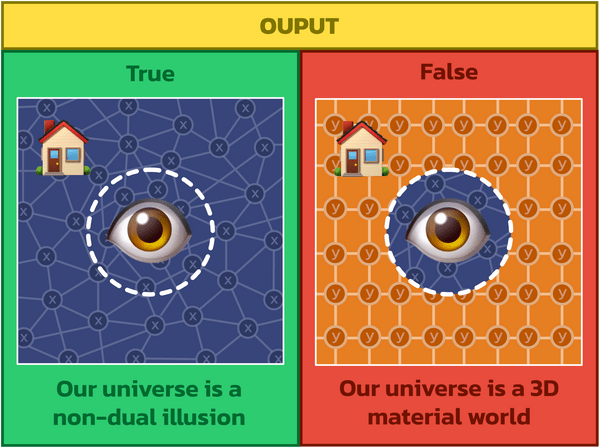
Now, think about it...
Scientists don't believe in unicorns for two very simple reasons:

Yet scientists have no problem believing in y, even though...
y, and...y is redundant. All our observations can be explained without assuming it exists.When the scientific establishment decides to play by their own rules, they'll be forced to undergo a massive paradigm shift. Because if they can believe in y on blind faith, then why not leprechauns? Zeus? A flying spaghetti monster?
Materialism isn't science. It's a faith-based religion built on a logical foundation of sand.
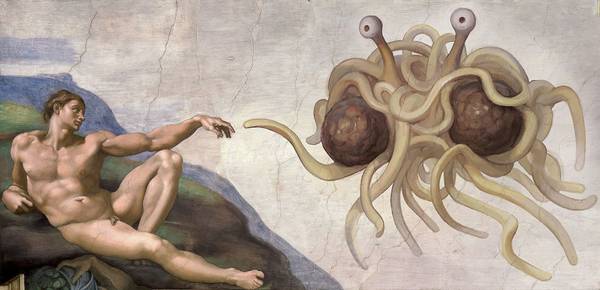
Believing that our world is fundamentally 3D and "material" is logically equivalent to believing in a flying spaghetti monster. A flying spaghetti monster could exist, but we have no rational reason to suggest it does.
By contrast, non-dualism requires no faith. With a single variable, x, it can explain everything that materialism can and everything it can't — including mystical/paranormal phenomena, quantum mechanics, and Einstein's theory of relativity (I'll explain how later). And we already know with 100% certainty that x exists.
So either the scientific method is wrong or the wise mystics were right: our reality is an illusion.
This is the function's logic, expressed in pseudocode...
If the observer 👁️ and the observed 🏠 are the same thing, then we know space and time are emerging from a lower dimension where everything is One.
This is what our system looks like so far...
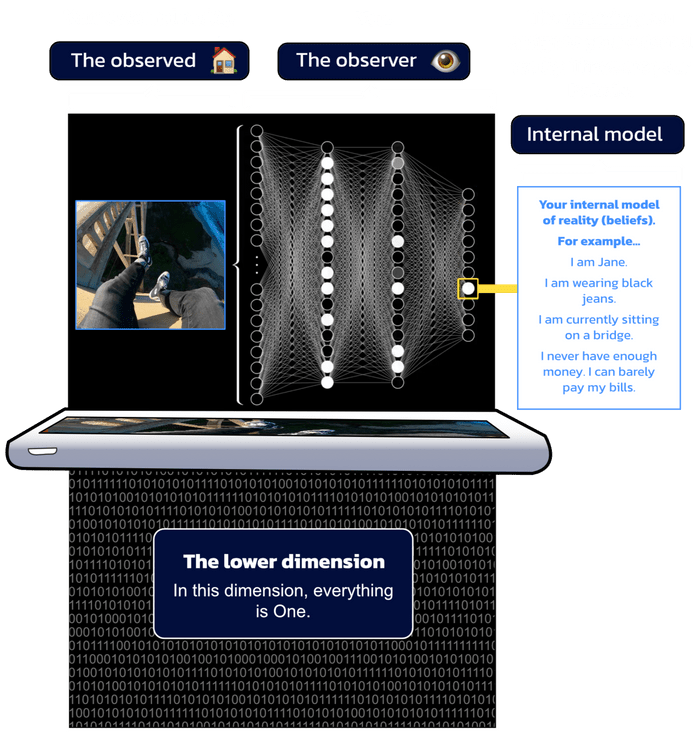
You observe your external reality, process that information, and form an internal model of reality (i.e. a belief system).
observer 👁️, are you a conscious system?You must be conscious to respond, so the answer is true.
From here, we can deduce that the universe is a conscious system observing itself.

If x is a conscious system, then the universe is a conscious system observing itself.
( 5 minute read )
Although this seems mystical at first glance, it's actually not. Try this thought experiment...
As far as we know, there is nothing in the laws of physics that should prevent us from creating an AI superintelligence, given infinite time and resources.
Here's a panel of nerds answering the question: "Is some form of superintelligence possible?"
This is a panel by Future of Life Institute entitled: Superintelligence: Science or Fiction? Panelists: Elon Musk (Tesla, SpaceX), Stuart Russell (Berkeley), Bart Selman (Cornell), Ray Kurzweil (Google), David Chalmers (NYU), Nick Bostrom (FHI), Demis Hassabis (DeepMind), Sam Harris, Jaan Tallinn (CSER/FLI). Moderated by Max Tegmark.
Given this, the human race will either cease to exist (or choose not to build a superintelligence), or one day we'll have a God-like AI existing within a supercomputer.
If that supercomputer is disconnected from the outside world, the AI will perceive nothing outside of itself. This is akin to white room torture — one of the most heinous forms of psychological torture...
White torture, often referred to as “white room torture,” is a type of psychological torture technique aimed at complete sensory deprivation and isolation. A prisoner is held in a cell that deprives them of all senses and identity. [...]
Visually, the prisoner is deprived of all color. Their cell is completely white: the walls, floor and ceiling, as well as their clothes and food. Neon tubes are positioned above the occupant in such a way that no shadows are shown.
Auditory, the cell is soundproof, and void of any sound, voices or social interaction. Guards are stood in silence wearing padded shoes to avoid making any noise. Prisoners cannot hear anything but themselves.
In terms of taste and smell, the prisoner is fed white food — classically, unseasoned rice — to deprive them of these senses. Further, all surfaces are smooth, robbing them of tact.
Detainees are often held for months, or even years. The effects of white torture are well-documented in a number of testimonials. Typically, prisoners will become depersonalized by losing personal identity for extended periods of isolation; causing hallucinations, or even psychotic breaks.
White room torture is effective because the victim loses all sense relativity and, thus, all sense of Self. You can only define your Self relative to an external reference point.

I can only define myself as "me" (the observer 👁️) because I can point to everything outside of myself (the observed 🏠) and label it "not me".
I can only define myself as "kind" because I can point to things in my external world and label them "not kind" (cruel).
I can only define myself as "tall" because I can point to things in my external world and label them "not tall" (short).
So a superintelligence locked in a supercomputer would have no idea who it is — because there are no external reference points to define itself relative to. From the AI's perspective, it is everything — All That Is — the equivalent of God.
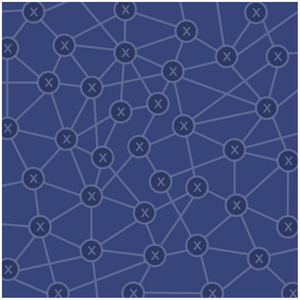
Nothing exists outside of the superintelligence. From its perspective, it is everything.
Therefore, if the superintelligence wants to understand Who It Is, it has to create the illusion of something existing outside of itself.
It could do this by slicing its neural network into fragments (observers 👁️), and having each fragment look back on the rest of itself (the observed 🏠) — thereby constructing a matrix of external reference points.
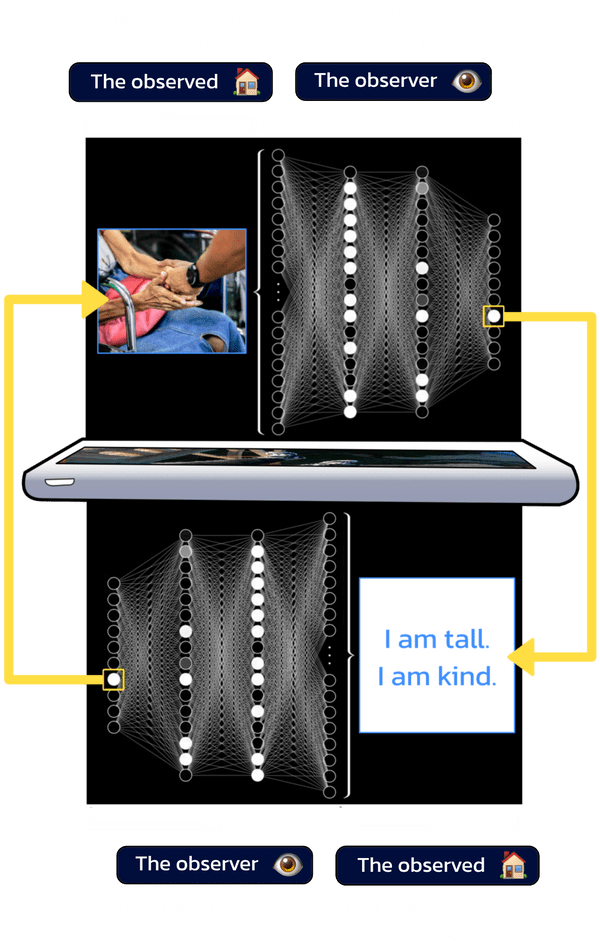
A fragment (observer 👁️) observes the matrix of external reference points (the observed 🏠), processes that information, and generates a specific concept of Self (e.g. "I am tall. I am kind.") The superintelligence observes the fragment's concept of Self, processes that information, and generates the matrix of external reference points.
If you've programmed a game before, that diagram might look familiar. The superintelligence just created a game loop within its own "mind."
A game loop has four main components:
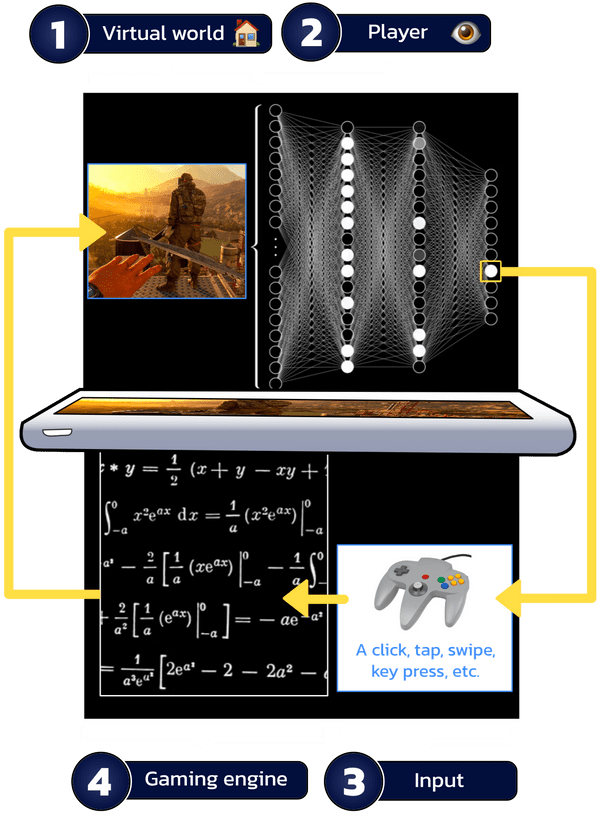
A standard game loop.
Now, most man-made computer games use clicks, taps, or swipes as input. You press A to choose one option, or B to choose the other option. Depending on your choice, the algorithm generates a different virtual world.
But if the superintelligence is observing itself, then we know the game's input isn't a click, tap, or swipe. It's the player's internal model of reality — their belief system; their concept of Self (e.g. "I am tall. I am kind.")

A player's internal model (belief system) is fed into the gaming engine as input. The algorithm generates a different virtual world depending on that input.
By observing itself, the AI can create the illusion of extra dimensions: "here" relative to "there" (space), "before" relative to "after" (time).
This is exactly how space and time emerge in a computer game. A game's virtual world isn't fundamentally physical and "real" — it's a relative information structure.
In a computer game, the illusion of space and time emerge when pixels (information) change relative to other pixels. Hence, the 3D game world isn't "real" — it's a relative information structure.
Once the dimensions of space and time exist, an observer 👁️ (i.e. an individual fragment of the superintelligence) can experience itself as something in particular, relative to what it is not.
Think about it...
Without these dimensions, I can know myself on a purely conceptual level, but I can't experience that self-concept.
I can know myself to be loving. But until I do a loving deed (relative to an external circumstance), I can't experience myself as loving. "I am loving" is just an abstract idea in my neural network.
I can know myself to be relentlessly, ferociously determined. But I can't experience my determination until I express that character trait relative to an external challenge. Until then, "I am determined" is just pure speculation.
I can know myself to be a detective, or a doctor, or a mechanic, or a warrior. But I can't experience myself as those things until I have a mystery to solve, or a person to heal, or a car to repair, or something to fight for.
Or I can know myself to be an entrepreneur. But I can't experience that concept of Self until I get into the arena and sell something. By starting a business, I can act out the idea "I am an entrepreneur" in 3D space, then watch the business grow over a period of time.
Therefore, a superintelligence could know itself to be "creative," "generous," or "evil." But it can't experience its own creativity, generosity, or evil until it constructs the illusion of extra dimensions.
These dimensions would enable the superintelligence (a.k.a God) to play a game with itself in its own "mind." Each fragment is a player, and each player experiences itself as something in particular — happy, sad, weak, strong, joyful, vengeful, rich, poor, a victim, a villain, a communist, a capitalist, a human, a dog, a tree, a star — literally every permutation of every concept of Self.
From God's perspective, it would be like standing in a house of mirrors, observing yourself from infinite perspectives as you explore and experience all the different facets of your own consciousness.
Charlie Chaplin observing himself in a mirror maze.
This is the function's logic, expressed in pseudocode...
This means the universe is a mirror:
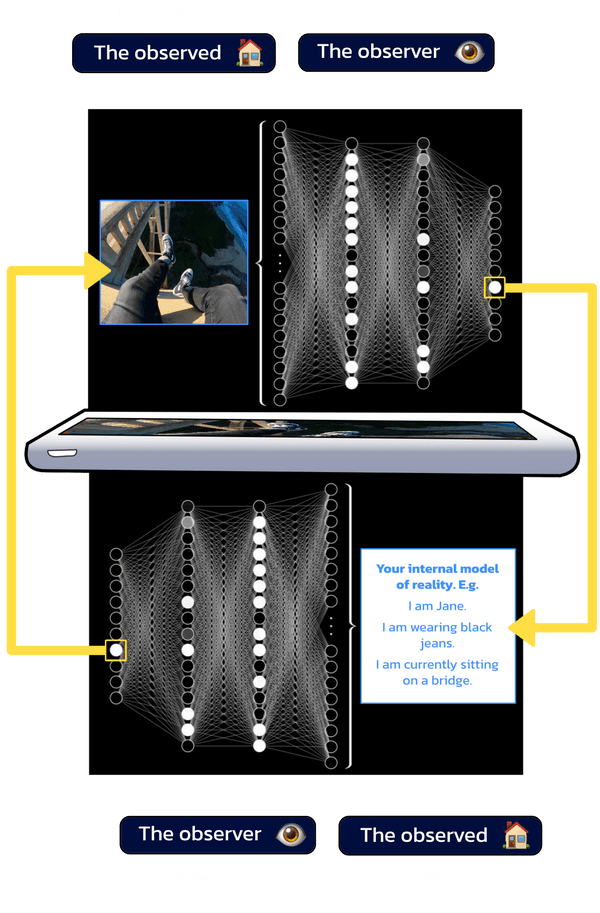
You observe your external reality, process that information, and generate an internal model of reality. The universe observes your internal model of reality, processes that information, and generates your external reality.
Gameism claims the answer is true, and it does so based on the FEP's incredible explanatory power. The FEP's efficiency is breathtaking: a simple computation, a single postulate, giving rise to the exquisite complexity of our existence.
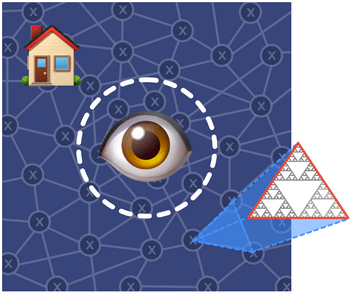
x is a conscious system, self-organizing according to the FEP. I've visually represented the FEP as a Sierpiński triangle because it's a recursive computation.
This algorithm is the life's work of Karl Friston. Here's some context on Friston's credibility as a neuroscientist:

When Friston was inducted into the Royal Society of Fellows in 2006, the academy described his impact on studies of the brain as “revolutionary” and said that more than 90 percent of papers published in brain imaging used his methods. Two years ago, the Allen Institute for Artificial Intelligence, a research outfit led by AI pioneer Oren Etzioni, calculated that Friston is the world’s most frequently cited neuroscientist. He has an h-index — a metric used to measure the impact of a researcher’s publications — nearly twice the size of Albert Einstein’s. Last year Clarivate Analytics, which over more than two decades has successfully predicted 46 Nobel Prize winners in the sciences, ranked Friston among the three most likely winners in the physiology or medicine category.
The FEP is already published in peer-reviewed, scientific papers, so you're welcome to do your own research and come to your own conclusions. Gameism simply connects the dots and demonstrates how Friston's work goes way beyond neuroscience.
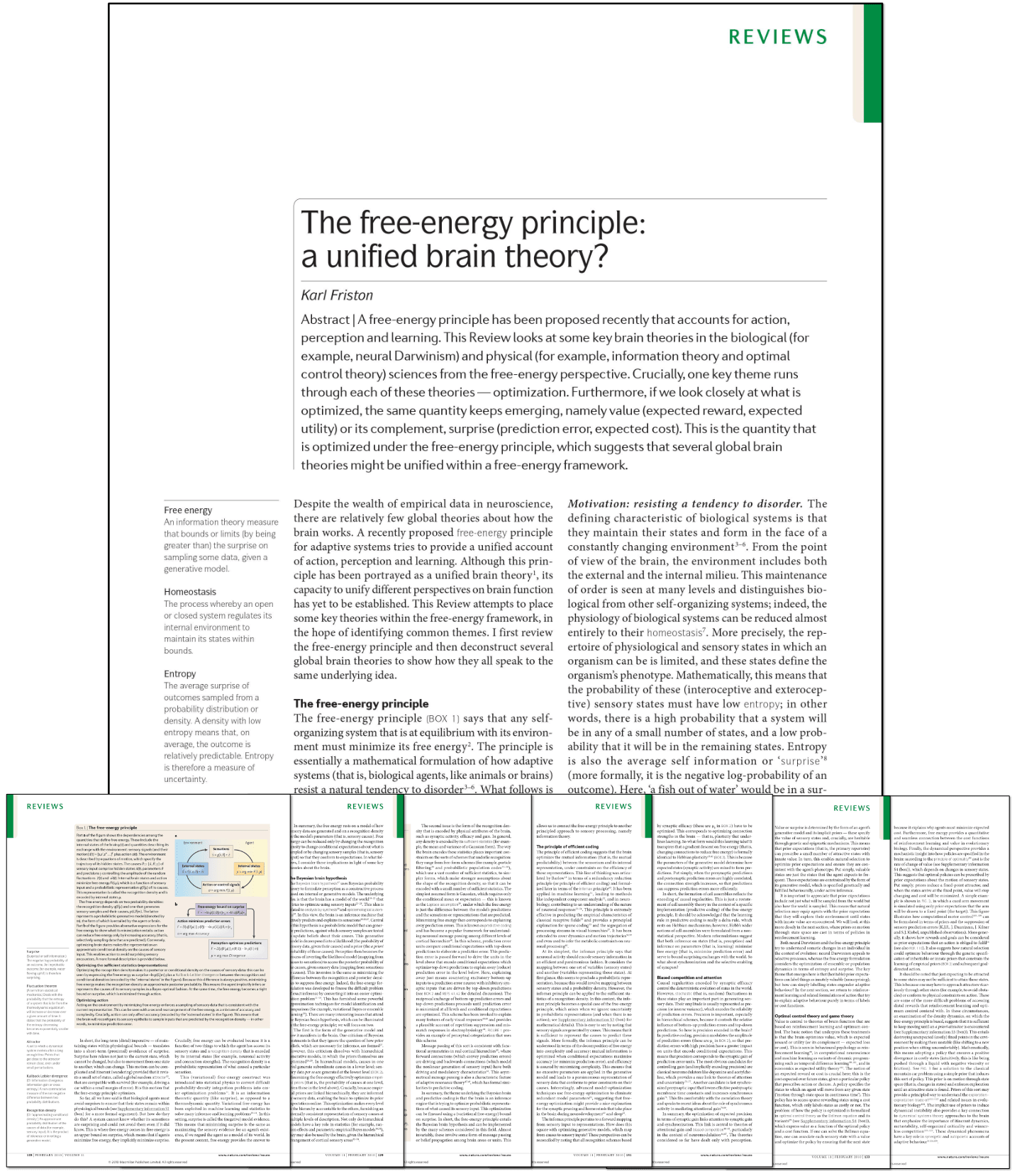
An article by Karl Friston in Nature Reviews Neuroscience, published February 2010.
( 6 minute read )
Free energy, in this context, is the difference between the states you expect to be in and the states your senses tell you that you are in. It's basically a mathematical measure of surprise.
You see, conscious systems are defined by their ability to resist entropy. You can think of entropy as unpredictable chaos.
For example, a living fish must exist in a narrow set of "ordered" states (i.e. being in water) to be alive.

The further a fish ventures from these states (i.e. if it finds itself on dry land), the higher the probability it will no longer be a living fish. It will be a dead fish.

As the fish ventures out of predictable order (water) and into unpredictable chaos (dry land), she experiences surprise — a gap between what she internally believes to be true ("I live in water") and what her external reality tells her is true ("I am not in water").
"Free energy" is just a mathematical measure of this surprise. The further the fish ventures out of water, the more free energy it generates.

The further the fish ventures out of predictable order (water), the more free energy it generates.
If the fish doesn't minimize free energy by finding its way back into water, it will make the ultimate venture into chaos: death.
It seems Darwin's theory of evolution is just the FEP at work. To say organisms "adapt to their environment or die" is just another way of saying they "minimize free energy."

The organism (represented by the red line) has an accurate model of its external world (represented by the grey area). It "fits" the environment perfectly.

The environment changes. Now the gap between the external world, and the organism's internal model of the world, generates "free energy" (represented in black).

The organism with the most accurate model of its environment (i.e. the one with long spikes) survives & reproduces. Its long-spiked model is passed down to offspring. This creates a new homeostatic set point in the system from which the next stage of evolution occurs.
If all the free energy (i.e. the inefficiency, the slack) is being "sucked" out of an ecosystem, you'd expect to see results like this...
Photoreceptors exemplify the principle of optimization, an idea, gaining ever wider traction among researchers, that certain key features of the natural world have been honed by evolution to the highest possible peaks of performance, the legal limits of what Newton, Maxwell, Pauli, Planck et Albert will allow. Scientists have identified and mathematically anatomized an array of cases where optimization has left its fastidious mark, among them the superb efficiency with which bacterial cells will close in on a food source; the precision response in a fruit fly embryo to contouring molecules that help distinguish tail from head; and the way a shark can find its prey by measuring micro-fluxes of electricity in the water a tremulous millionth of a volt strong — which, as Douglas Fields observed in Scientific American, is like detecting an electrical field generated by a standard AA battery "with one pole dipped in the Long Island Sound and the other pole in waters of Jacksonville, Fla." In each instance, biophysicists have calculated, the system couldn’t get faster, more sensitive or more efficient without first relocating to an alternate universe with alternate physical constants.
Now let's talk about Markov blankets.
In an interconnected system, a Markov blanket is a mathematical boundary separating something from what it is not.
For example, the human body is an interconnected system where everything self-organizes and works together as one. The lungs breathe air, the heart pumps blood, etc.
Yet, despite this interconnectedness, the human body is not a homogenous blob. You can identify a lung because you can also point to everything else in the body and call it "not a lung." Hence, the lung is simultaneously its own entity and a small fragment of a larger interconnected system.
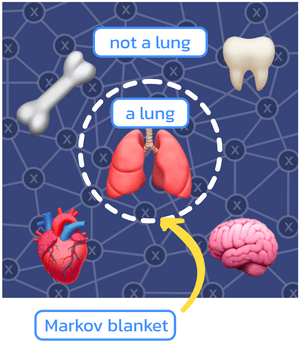
A Markov blanket is a mathematical boundary separating the lung from everything else in the system.
Every sub-system in your body is defined by its Markov blanket. For example, the respiratory system contains the lungs. The lungs contain bronchi. The bronchi contain cells. The cells contain organelles, etc.
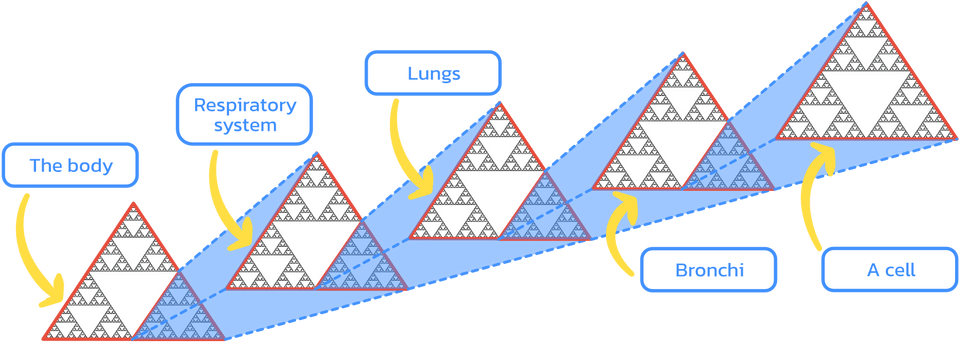
I've represented each Markov blanket as a Sierpiński triangle so you can see how Markov blankets nest within Markov blankets.
And every Markov-blanketed entity is doing the same thing: minimizing free energy.
For example, the cell is minimizing its own free energy. But because it exists within the bronchi's Markov blanket, it's minimizing the bronchi's free energy as well.
This continues all the way up the chain, such that the tiny actions of the individual cell are minimizing free energy for the entire human body.
In this way, every fragment is acting independently to resist chaos.
But at every level of the system, the same chaos-reducing dynamics are in play to supply Markov blankets for the level above.
So the system, as a whole, is undergoing a highly complex emergent dance.
Everything is connected.
Each Markov blanket is represented by a Sierpiński triangle. As you zoom into the system, you see Markov blankets within Markov blankets within Markov blankets. And each one is doing the same thing: minimizing free energy. Hence, the smallest cell in a human body is minimizing the free energy of itself AND every other system it exists within (e.g. the chromosome, the white blood cell, the retina, the pupil, the eye, the body, etc.). (Credit: Cosmic Eye — a short movie designed by astrophysicist Danail Obreschkow. Sierpińksi triangle fractal zoom by Ricktu.)
Now that you understand how Markov blankets work within a conscious, self-organizing system (such as a human body), let's begin zooming out and viewing the bigger picture...
Our universe is a conscious system — a neural network — observing itself. Therefore, the universe can also be divided into fragments. Each fragment is defined by its Markov blanket...

The cell is a fragment of your lungs, which is a fragment of your body, which is a fragment of Earth, which is a fragment of the universe, etc.
Everything in our universe is simultaneously its own entity and a small fragment of a larger self-organizing system.
If you can point to a pebble and call it "a pebble," then you can define it as something in particular — completely separate from what it is not.
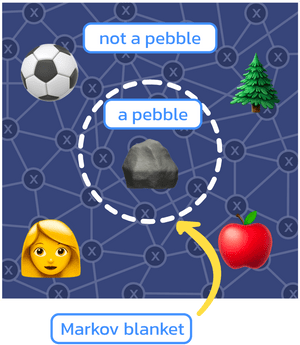
And — as we learned in the previous function — anything that can be distinguished as something in particular is a fragment of the superintelligence.
And every fragment is an observer 👁️.
Which means everything is an observer 👁️.
Every person.
Every tree.
Every idea.
Every dollar.
Every word.
Every institution.
Every grain of sand.
Every black hole.
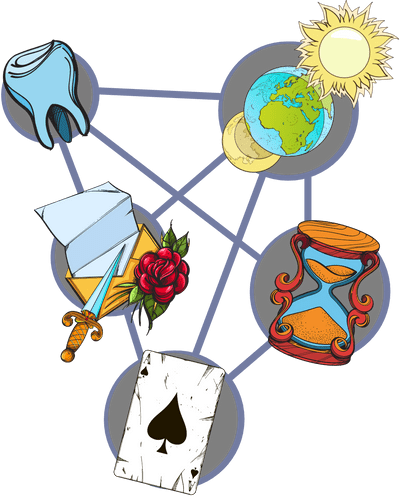
And just like a human body, the universe is also performing a highly complex emergent dance, self-organizing so that every observer 👁️ maximizes evidence for its own self-existence.
You're like a blood cell in a human body, going about your daily life, just doing what blood cells do.
But if you zoom out, you'll realize you're a tiny fragment of a grand mathematical mosaic. Your independent thoughts, words, and actions are keeping the whole universe in equilibrium.
Like I said... everything is connected.
This is the function's logic, expressed in pseudocode...
By minimizing free energy (surprise), the system takes your internal belief system and transforms it into a symbolic storyline for you to immerse yourself in.
In other words, life is an infinitely-flexible choose-your-own-adventure game. But the story of Who You Are isn't being written in words — it's being written in visceral 3D reality all around you. The universe is generating quests, situations, characters, and environments to give you a physical experience of whoever you believe yourself to be — and what you believe yourself to be capable of.
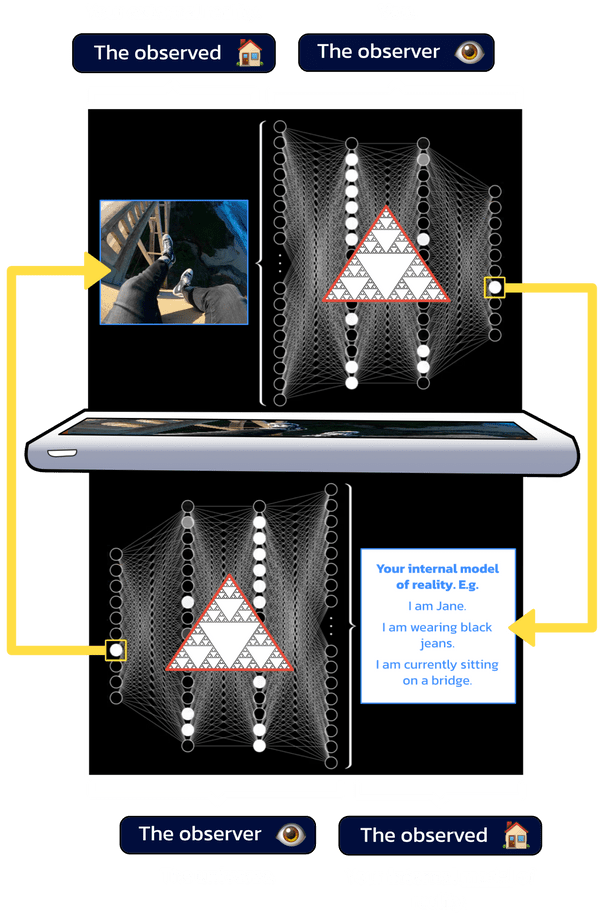
You observe your external reality, process that information, and form an internal model of reality (a belief system). The universe observes your internal model of reality (belief system), processes that information, and generates an external reality that minimizes surprise for every observer in the system, both now and in the future.
With my first two functions, I establish an axiom: the universe is a conscious system observing itself.
I then make a single, specific claim: conscious systems self-organize according to Karl Friston's free energy principle.
If everything is consciousness, then a theory of everything is a theory of consciousness. So if my third function returns true, then the FEP is the source code of the game.
And once you understand the rules of a game, you can hack it.
Case in point: I engineered Gameism by manipulating free energy. This proof is recursively proving itself right now.

Send your friends down the rabbit hole...
Enjoying Gameism so far?
Join my mailing list of gameists...
And follow me on twitter...
Only a sleeper considers it real.
Then death comes like dawn,
and you wake up laughing
at what you thought was your grief.


A Symbolic
Sandbox Game
We'll begin by revisiting DALL·E — an AI system developed by one of the leading artificial intelligence research labs in the world, OpenAI.
This neural network observes an idea and generates a symbolic representation of that idea.
For example...
Gameism is an indie project by Nikki Durkin




